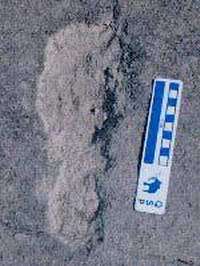Will a footprint rewrite the history books?

Scientists have unearthed human footprints in central Mexico which they claim are around 40,000 years old, shattering previous theories on how humans first colonised the Americas.
The researchers hope that their preliminary findings will eventually help shed light on one of the most contentious debates in American history: who was there first and how did they get there?
An international team of geoarchaeologists, led by Dr Silvia Gonzalez from Liverpool John Moores University (LJMU), who discovered the footprints in an abandoned quarry in September 2003, have subjected them to a number of dating techniques. These include Uranium series dating carried out on animal bones from the site by Dr Alistair Pike of Bristol University’s Department of Archaeology and Anthropology.
The researchers analysed 269 footprints, both animal and human, found close to the Cerro Toluquilla volcano in the Valsequillo Basin, near the city of Puebla, 130 km southeast of Mexico City.
The footprints were preserved as trace fossils in volcanic ash along what was once the shoreline of an ancient volcanic lake. Climate variations and the eruption of the Cerro Toluquilla volcano caused lake levels to rise and fall, exposing the Xalnene volcanic ash layer. Early Americans walked across this new shoreline, leaving behind footprints that soon became covered in more ash and lake sediments. The trails became submerged when the water levels rose again, preserving the footprints.
Today, the Xalnene ash, now as hard as concrete, is used locally as a building material. Dr Gonzalez and her research team were able to see the footprints without carrying out any excavation as quarry workers had already removed between 2 – 3 metres of lake sediments that had been deposited on top of the volcanic ash.
The footprints were mapped and scanned using laser technology and reproduced as 3-d images and models at the University of Bournemouth. Approximately 60 per cent of the prints were found to be human, with 36 per cent of the human prints classified as children’s because of their size. Several short trails of footprints are visible in some parts of the quarry and it is estimated that the adult humans were between 117 and 190 cm tall.
The team used a number of techniques to date the footprints and the sediments above and below these trace fossils, including Uranium series dating carried out on animal bones from the Valsequillo Gravels by Dr Pike.
Dr Pike said: “At Bristol we have developed a method of dating bones using the decay of uranium. This is particularly useful in Mexico because many of the bones there are too weathered to be dated by radiocarbon.
“We were working with the team from LJMU and Oxford on a project dating human remains in Mexico when the footprints were discovered. Dating footprints presented a bigger challenge than the bones we were dating, so we assembled a team of experts, including scientists from The Open University in the UK and the Australian National University.
“We had to visit the site several times to hunt for bones, teeth, shells, peat, volcanic lava, quartz rich sediments and other materials suitable for dating. It took us nearly two years, but we really wanted to be sure we got the dating right, especially since such an early date will radically change our understanding of the peopling of The Americas.”
The results of this extensive dating programme indicate that the human and animal footprints preserved in the upper part of the Xalnene Ash are older than 40,000 years, thus posing serious challenges to considered wisdom on the settlement of the continent.
The traditional view – known as the Clovis First Model – is that settlers crossed the Bering Straits, from Russia to Alaska, at the end of the last ice age – around 11,500 to 11,000 years ago. Evidence for this theory comes from Clovis Points – tools used to hunt mammoths and mastodonts – found from many locations in the American continent.
The discovery of human footprints in the Valsequillo Basin of Central Mexico challenges this model, providing new evidence that humans settled in the Americas as early as 40,000 years ago.
Dr.Gonzalez said: “New routes of migration that explain the existence of these much earlier sites now need urgent consideration. Our findings support the theory that these first colonists may perhaps have arrived by water rather than on foot using the Pacific coast migration route.”
For further information on the footprints research, including how the footprints were dated, and mapped, visit www.mexicanfootprints.co.uk
Source: Bristol University

















